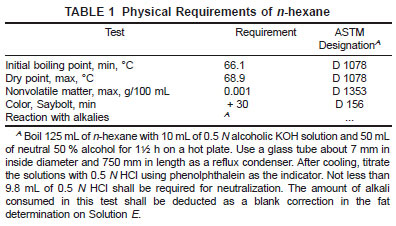5. Reagents
5.1 Purity of Reagents - Reagent grade chemicals shall be used in all tests. Unless otherwise indicated, it is intended that all reagents shall conform to the specifications of the Committee on Analytical Reagents of the American Chemical Society, where such specifications are available. Other grades may be used, provided it is first ascertained that the reagent is of sufficiently high purity to permit its use without lessening the accuracy of the determination.
5.2 Purity of Water - Unless otherwise indicated, references to water shall be understood to mean reagent water conforming to Specification D1193, Type III.
5.3 Acetone - American Chemical Society Reagent Grade Acetone. (Warning - Extremely flammable. Vapors may cause flash fires.)
5.4 Alcohol (50 %) - The alcohol shall be prepared from commercial 95 % ethanol or denatured alcohol (Warning - Flammable. Denatured. Cannot be made non-toxic) by distilling from NaOH and neutralizing exactly with NaOH or KOH using phenolphthalein as the indicator. (Warning - In addition to other precautions, avoid skin contact or ingestion.) Dilute with an equal volume of water.
5.5 Ammonium Carbonate - (NH4)2CO3. (Warning - Harmful if swallowed.) (Warning - Harmful if swallowed.)
5.6 Butter Yellow Indicator (0.02 g/mL) - Toluene solution (Warning - Flammable.Vaporharmful)of p-dimethylaminoazobenzene. (Warning - Suspected carcinogen. In addition to other precautions, avoid inhalation or skin contact.)
5.7 t-Butyl Alcohol, melting point 24 to 25.5°C (Warning - Flammable liquid; causes eye burns).
5.8 Carbon Disulfide (CS2). (Warning - Extremely flammable. Poison. Vapor may cause flash fire. Vapor harmful. Capable of self-ignition at 100°C or above. Harmful or fatal if swallowed. May be absorbed through the skin.)
5.9 Ethyl Ether. (Warning - Extremely flammable. Harmful if inhaled. May cause eye injury. Effects may be delayed. May form explosive peroxides. Vapors may cause flash fire. Moderately toxic. Irritating to skin.)
5.10 n-hexane, high-purity grade, conforming to the requirements of Table 1. (Warning - Extremely flammable. Harmful if inhaled. May produce nerve cell damage. Vapors may cause flash fire.)

5.11 Hydrochloric Acid (37 %) - Concentrated acid (HCl). (Warning - Poison. Corrosive. May be fatal if swallowed. Liquid and vapor cause severe burns. Harmful if inhaled.)
5.12 Hydrochloric Acid, Standard Solution (0.5 N) - Prepare and standardize a 0.5 N solution of HCl.
5.13 Hydrochloric Acid (10 %), a solution containing 10 % by weight of concentrated HCl in water, with a permissible variation of 0.5 %.
5.14 Hydrochloric Acid (1 + 3) - Mix one volume of concentrated HCl (37 %) with three volumes of water.
5.15 Methyl Red Indicator Solution. (Warning - Flammable. Avoid skin contact or ingestion.)
5.16 Nitric Acid (1 + 4) - Mix one volume of concentrated nitric acid (70 %) (Warning - Poison. Corrosive. Strong oxidizer. Contact with organic material may cause fire. May be harmful if swallowed. Liquid and vapor cause severe burns) with four volumes of water.
5.17 Phenolphthalein Indicator Solution - The phenolphthalein solution shall be prepared by dissolving 1.0 g phenolphthalein (Warning - In addition to other precautions, avoid skin contact or ingestion) in 50 mL of alcohol distilled as described in 5.4, adding 5 mL of water and neutralizing with NaOH or KOH.
5.18 Potassium Hydrogen Sulfate (KHSO4). (Warning - Poison. Harmful or fatal if swallowed. Causes severe eye and skin irritation or injury. Dust or mist may be harmful.)
5.19 Potassium Hydroxide (KOH), Alcoholic (0.5 N) - Prepare and standardize a 0.5 N solution of alcoholic potassium hydroxide. (Warning - Poison. Causes eye and skin damage.)
5.20 Potassium Periodate (KIO4). (Warning - May be irritating to skin and eyes. May react vigorously with reducing agents.)
5.21 Sodium Carbonate - (Na2CO3). (Warning - Harmful if swallowed. May cause skin irritation.)
5.22 Sodium Hydroxide (240 g/L) - Dissolve 240 g of sodium hydroxide (NaOH) (Warning - Poison. Causes eye and skin damage) in water and dilute to 1 L.
5.23 Sodium Hydroxide Solution, Standard (0.05 N) - Prepare and standardize a 0.05 N NaOH solution.
5.24 Sulfuric Acid (1 + 4) - Carefully mix one volume of concentrated sulfuric acid (H2SO4 95 %) with four volumes of water. (Warning - Poison. Corrosive. Strong oxidizer. Contact with organic material may cause fire. May be fatal if swallowed. Liquid and vapor cause severe burns. Harmful if inhaled. Contact with water liberates large amounts of heat.)
5.25 Sulfuric Acid (3 + 20) - Carefully mix 3 mL of concentrated sulfuric acid (95 %) with 20 mL of water.
5.26 Toluene. (Warning - Flammable. Vapor harmful.)
6. Sample
6.1 The sample size for the soap determination (Test Methods I and II for determination of insolubles, soap, fat, petroleum oil, and unsaponifiable matter) shall be from about 8 to 30 g, depending on the consistency of the grease, which is chiefly determined by the percentage of soap present. A 10 to 20-g sample is usually a convenient amount for No. 3 cup grease, while softer greases require a larger sample. The original sample shall be stirred or mixed until uniform.
6.2 Samples need not be weighed more closely than to 0.1 g.



